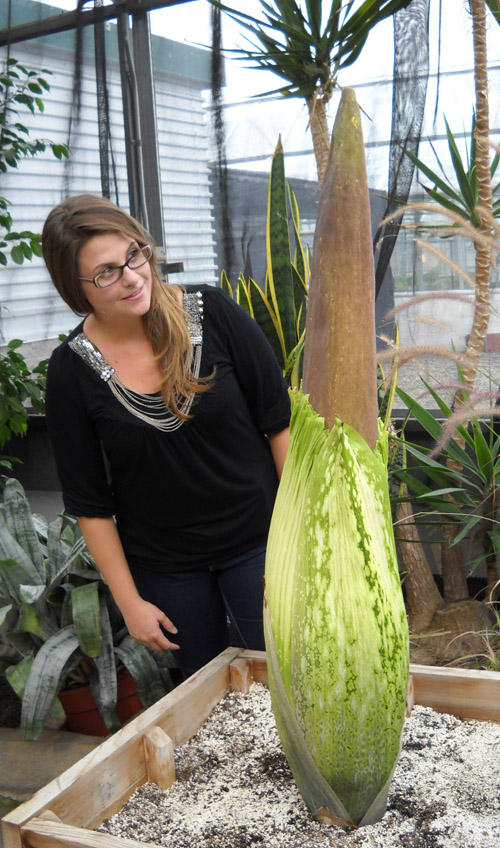
It’s the largest and maybe the stinkiest flower in the world. And any day now you can catch the rare blooming of a corpse flower in a campus greenhouse – and help U of G’s United Way campaign at the same time.
One of four titan arum plants in the Bovey Building greenhouse may bloom this weekend in an unusual but eye-catching event. In return for a look and a whiff of the stinky flower, visitors will be asked to make a donation to the United Way fundraising campaign run by the Department of Plant Agriculture.
United Way volunteer and PhD student Fawn Turner says the plant might bloom by Friday, but the department will open the greenhouse and arrange for volunteers over the weekend if needed. The rare-blooming flower lasts for only one or two days.
The Bovey greenhouse is open today and Friday from 8:30 a.m. to 4:30 p.m. If the corpse flower blooms over the weekend, an announcement and viewing hours will be posted on the website for the University’s trial garden.
Turner isn’t sure how many visitors to expect, although she says occasional blooms elsewhere have attracted attention. “It’s hard to judge. Two plants bloomed at the Niagara Parks earlier this year and drew quite a large crowd.”
Amorphophallus titanum draws eyes and noses with its unusual bloom and with its smell, likened to rotting flesh. In its native Sumatran home, the odour attracts pollinators such as carrion beetles. Commenting on the plant’s “perfume,” Rodger Tschanz, manager of the University’s trial gardens, says, “It’s pretty close to a rotting mouse.”
The spectacular bloom consists of a fleshy column growing out of a single large red-maroon “skirt.” The actual flowers are hidden in a cluster around the base of the column.
The largest recorded specimens have reached eight or even 10 feet high. Many botanists consider titan arum’s bloom to be the world’s largest. The unopened flower is housed in a knee-high planting box in the Bovey greenhouse.
Two other corpse plants bloomed in the Bovey greenhouse earlier this year, but their flowers were damaged. When Tschanz realized that a third plant was set to bloom this fall, he suggested making the event a United Way fundraiser. The department’s campaign co-ordinators – Turner and Prof. Ralph Martin – hope to raise $21,500 this year.
“It’s a pretty rare spectacle,” says Turner. “Rodger wanted to have it on display for the public and the University community to see, and what better way to tie into a good cause?”
Tschanz raised all four titan arums from seed obtained in 2001 from the University of Wisconsin-Madison. It can take about a dozen years for a plant to bloom for the first time. After that, blooms might occur every two years or so.
The Niagara Parks grew specimens to help attract visitors, says Tschanz. Here at Guelph, it was mostly curiosity that impelled his titanic project.
Note: Find other United Way events at www.uoguelph.ca/unitedway.